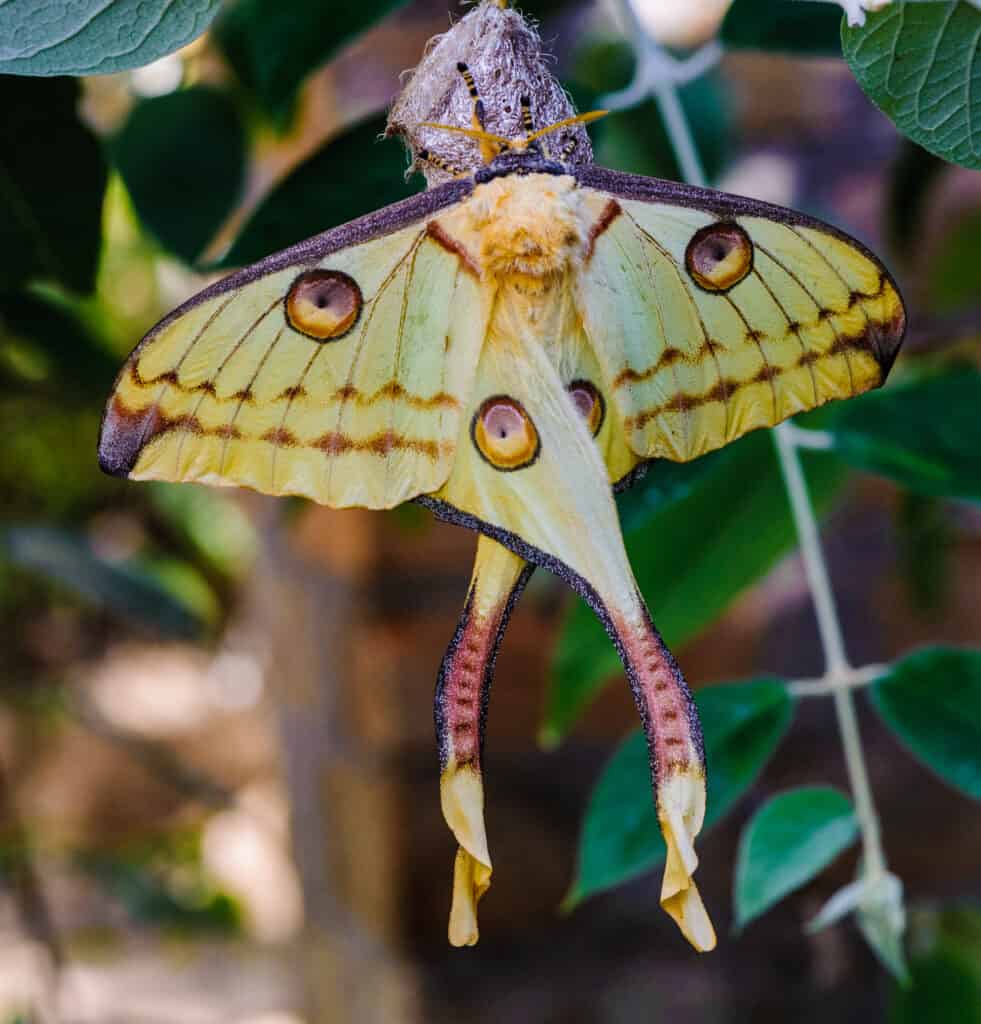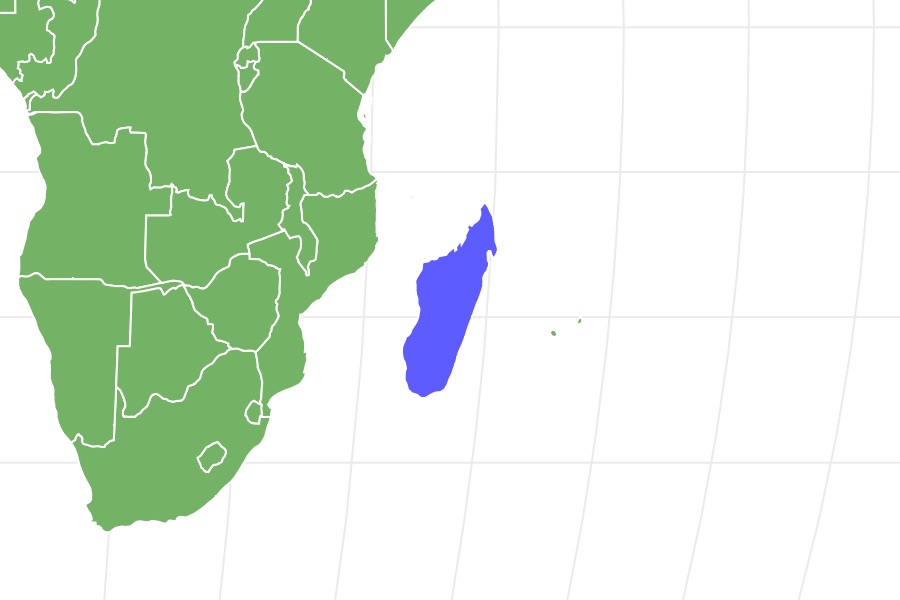Comet Moth
Argema mittrei
Adult comet moths do not feed at all till they die less than 12 days later.
Advertisement
Comet Moth Scientific Classification
- Kingdom
- Animalia
- Phylum
- Arthropoda
- Class
- Insecta
- Order
- Lepidoptera
- Family
- Saturniidae
- Genus
- Argema
- Scientific Name
- Argema mittrei
Read our Complete Guide to Classification of Animals.
Comet Moth Conservation Status
Comet Moth Facts
- Name Of Young
- Caterpillar
- Group Behavior
- Largely solitary
- Smack
- Fun Fact
- Adult comet moths do not feed at all till they die less than 12 days later.
- Estimated Population Size
- 120 -170 eggs
- Biggest Threat
- Extermination by humans, Deforestation
- Most Distinctive Feature
- Long, Red and Yellow Tail
- Other Name(s)
- Madagascan Moon Moth
- Wingspan
- 7.9 inches
- Litter Size
- 120 - 170 eggs
- Predators
- Bats
- Diet
- Omnivore
- Lifestyle
- Nocturnal
Comet Moth Physical Characteristics
- Color
- Brown
- Yellow
- Red
- Green
- Skin Type
- Exoskeleton
- Lifespan
- Less than 12 days
- Venomous
- No
- Aggression
- Low
View all of the Comet Moth images!
Comet moths don’t eat – the adult moth only lives for about 4 – 5 days.
Madagascan moon moth is another name for Comet Moth, scientifically known as Argema mittrei, and is among the largest species of wild silk moths. The rainforest areas of Madagascar are the natural habitat of the Moth, and they mainly feed on the nectar of the host plants. The tail length of the male Moth is up to 15 cm, and the wingspan is about 20 cm wide. Cometh moths have a very short lifespan. The male Moth’s lifespan is a meager 4 – 5 days, whereas the females can last 7 – 10 days.
Comet Moth Species, Types, and Scientific Name
Comet Moth is the common name of Arkema mittrei, an insect that shares the order Lepidoptera with other butterflies and moths. It belongs to the family of Saturniidae, which contains an estimated 2,300 described species of moths. Some of the largest moths in the world belong to this family, including species like emperor moths, giant silk moths, and royal moths.
The comet moth is also known as the Madagascan moon moth since it is naturally found in the rainforests of Madagascar in Africa. The species was first identified and described in 1847 by Félix Édouard Guérin-Méneville. .
Appearance: How to Identify Comet Moths
The name comet moth was given to this insect in reference to their long tails, one of their most striking features. The large wings of the comet Moth come in vibrant colors of red and yellow. These colors and intricate patterns help keep the insect camouflaged during the day.
In terms of size, Comet moths are among the largest silk moth species in the world. Females are typically smaller than males. The male Madagascan moon moth has a wingspan of about 20 cm (7.9 inches), while the tail span measures about 15 cm (5.9 inches). Another key difference is that the male Moth has long, feathery antennas while the female antenna is significantly thinner.
One of the most striking features of the Argema mittrei is the large eyespots on the upper and lower part of the Moth’s wings. In fact, the genus “Argema” means “speckled eye” in greek. These eyespots give the moth the appearance of a much larger and more dangerous creature to predators, which helps to protect the moth from attack.

©Anton_Ivanov/Shutterstock.com
Habitat: Where To Find Comet Moth
Comet moths are found naturally in Madagascar and nowhere else in the world. The Comet Moth’s natural habitat is the deepest part of the rainforests. However, they can also be bred in captivity. Comet Moths are quite vulnerable because they depend on certain plants in their habitat. This dependency limits their habitat range to specific locations.
Today, their habitat is limited to the rainforests located south and east of Madagascar’s capital. Sadly, the species’ survival is currently threatened by slash-and-burn agricultural activities, which are causing the disappearance of the plants the moths feed on.
Diet: What Do Comet Moths Eat?
The Madagascan Moon Moth only feeds when it is in the caterpillar stage. Females lay eggs that hatch into caterpillars between 10 to 20 days after laying the eggs. The caterpillar spends 2 months in this stage, feeding aggressively.
What Do Comet Moths Eat?
Eucalyptus leaves are the primary food source for the caterpillars. They may also feed on plants in the Eugenia and Weinmannia genus. Some of their preferred plants include Weinmannia eriocampa, Uapaca species, Sclerocarya caffra, and Eugenia cuneifolia. However, if these plants are unavailable, they may feed on alternatives like the Pistacia terebinthus, Rhus cotinus, and Eucalyptus gunnii.
The caterpillars feed aggressively on these plants until they fill up their chitin shells tightly, after which they stop to molt. Once the old molt is removed and new skin appears, they’ll resume eating. This procedure is repeated 3 to 4 times within the next two months, allowing the formerly dwarf caterpillars to grow into bright green giant caterpillars.
After the caterpillar develops into an adult moth, the direct feeding stops. The caterpillar already relies on the food it has already eaten for the next few days it’ll live. Although the insect has a mouth, it has evolved not to use it over the centuries. The male moth is only alive for 4-5 days. However, the females usually live longer (about 7 to 10 days)
What Eats Comet Moths?
Like all butterflies and moths, Comet moths have several natural enemies. These predators feed on both the caterpillars and adult insects. Chameleons, geckos, bats, and birds feed on the insect as part of their diet. In addition to the colorful camouflage and tails that they use to protect themselves from predators, moths have also evolved an echolocation dampening feature that protects them from insects like bats that use ultrasound for hunting food. A much bigger threat to the existence of comet moths is deforestation, leading to habitat loss in their native land.
View all 235 animals that start with CComet Moth FAQs (Frequently Asked Questions)
Are Comet Moths dangerous?
No! Comet moths are not dangerous to humans, although the dust coating the wings and the feathery antennae of the male moths can be an allergy source for some people. However, some species of moths are dangerous to crops such as corns, sorghums, and apples, especially their caterpillars.
How many legs does Comet Moth have?
There is no difference in the number of legs of Comet Moth and other species of moths. The adult Moth has three pairs of legs totaling six legs but is different from caterpillars. The anatomy of the caterpillar is different from an adult moth’s. The first three pairs of legs near the head of the caterpillars are referred to as the true legs, and they are similar to the adult moth’s legs. At the rear, there are five other legs known as the fake legs; thus, they are not regarded as legs.
How long does a comet moth live?
The lifespan of an adult Comet Moth is between 4 – 5 days, although a female moth lives more prolonged than that. The female Moth’s lifespan is between 7 – 10 days as it may take time for them to get paired. Also, the fat content in the body the female moths is more than that of males. The caterpillar’s lifespan is usually two months before it encloses itself in a cocoon.
How do you identify Comet moths?
Vibrantly colored red and yellow wings characterize comet moths. Their wings feature prominently long tails (hence the name, comet). The large wings have intricate patterns, including big eye spots on the upper and lower wings. Male comet moths are typically larger than female ones.
Are comet moths rare?
Yes. Comet moths are quite rare. They only exist naturally in the wild in Madagascar. Even here, they’re fast becoming depleted due to habitat loss from deforestation and agricultural activities. However, the comet moth can be bred in captivity as well.
What do comet moths eat?
Comet moths do not eat. The adult moth lives for less than 12 days. During this time, it survives on the supply of sap built up from the caterpillar’s feeding activities. The Moth’s trunk has shriveled over years of evolution, so it can’t be used anymore.
Which country does the comet moth live in?
Comet moths are native to Madagascar. Another common name for this moth is the Madagascan moon moth because it is only found in the rainforest of Madagascar.
Thank you for reading! Have some feedback for us? Contact the AZ Animals editorial team.
Sources
- Natural History Museum, Available here: https://www.nhm.ac.uk/discover/spotlight-madagascan-moon-moth.html
- Kidadl, Available here: https://kidadl.com/facts/animals/comet-moth-facts-you-wont-believe
- The Butterfly Babe, Available here: https://www.thebutterflybabe.com/species/argema-mittrei
- Mada Magazine, Available here: https://www.madamagazine.com/en/ein-kurzes-buntes-leben-der-kometenfalter/

















